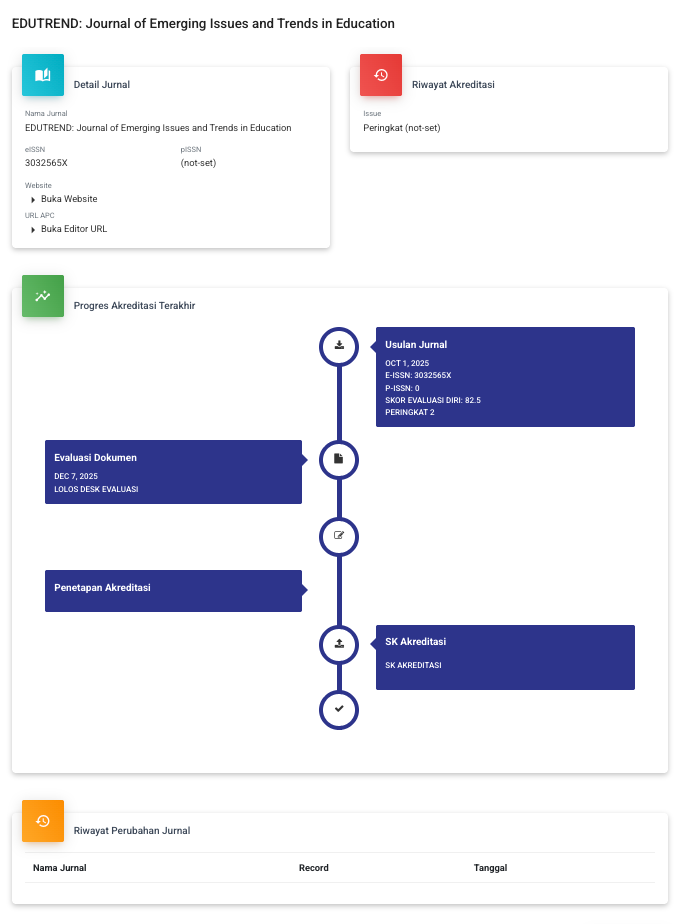Challenges and Opportunities of E-Learning for Women's Education in Developing Countries: Insights from Women Online University
DOI:
https://doi.org/10.59110/edutrend.310Keywords:
Developing Countries, Digital Literacy, E-Learning, Socio-Economic Advancement, Women's EducationAbstract
This case study explores the challenges and opportunities of e-learning for women's education in developing countries, focusing on the experience of Women Online University. The purpose is to assess the impact of e-learning on women's empowerment and socio-economic advancement, examining factors influencing engagement with e-learning platforms. The study involved 220 female students across various faculties and age groups, utilizing surveys and statistical analysis to evaluate e-learning effectiveness. Results indicate a positive perception of e-learning, with significant relationships between e-learning contribution, empowerment, and socio-economic advancement. Access to technology is influenced by digital literacy, age, and faculty of study. In conclusion, the study highlights the transformative potential of e-learning for women's education, emphasizing the importance of addressing digital literacy gaps and enhancing institutional support. Recommendations include leveraging innovative pedagogical strategies to optimize e-learning outcomes and promote gender equality in education. This case study contributes valuable insights into the role of e-learning in empowering women in developing countries, informing future research and policy initiatives in educational development and gender equality efforts.
References
Al Alhareth, Y. (2013). E-learning contribution to the enhancement of higher education opportunities for women in Saudi Arabia (Pilot study). US-China Education Review A& B, USA, 3(9), 637-648.
Al Alhareth, Y., Al Alhareth, Y., & Al Dighrir, I. (2015). Review of women and society in Saudi Arabia. American Journal of Educational Research, 3(2), 121-125.
Amiri, F., Quraishi, T., Hakimi, M., & Fazil, A. W. (2024). Assessing The Efficiency of Web-Hosted E-Learning Platforms in Afghanistan Academic Settings: An Exploration at Herat University. EDUTREND: Journal of Emerging Issues and Trends in Education, 1(1), 39-56. https://doi.org/10.59110/edutrend.309
Bertaux, N., & Crable, E. (2007). Learning about women. Economic development, entrepreneurship and the environment in India: A case study. Journal of Developmental Entrepreneurship, 12(04), 467-478.
Bower, B. L., & Hardy, K. P. (2004). From correspondence to cyberspace: Changes and challenges in distance education. New directions for community colleges, 2004(128), 5-12.
Cheris, K., & Kramarae, C. (2001). The Third Shift: Women Learning Online. International Women Online Journal Of Distance Education, 4(2).
Chick, N., & Hassel, H. (2009). " Don't Hate Me Because I'm Virtual": Feminist Pedagogy in the Online Classroom. Feminist Teacher, 19(3), 195-215.
Fazil, A. W., Hakimi, M., Sajid, S., Quchi, M. M., & Khaliqyar, K. Q. (2023). Enhancing Internet Safety and Cybersecurity Awareness among Secondary and High School Students in Afghanistan: A Case Study of Badakhshan Province. American Journal of Education and Technology, 2(4), 50–61. https://doi.org/10.54536/ajet.v2i4.2248
Fazil, A. W., Hakimi, M., Shahidzay, A. K., & Hasas, A. (2024). Exploring the Broad Impact of AI Technologies on Student Engagement and Academic Performance in University Settings in Afghanistan. RIGGS: Journal of Artificial Intelligence and Digital Business, 2(2), 56–63. https://doi.org/10.31004/riggs.v2i2.268
Gokah, T. K., Gupta, N., & Ndiweni, E. (2015). E-Learning in higher education–opportunities & challenges for Dubai. International Journal on E-learning, 14(4), 443-470.
Hakimi, M., Fazil, A. W., Ahmady, E., Qarizada, A., & Quraishi, T. (2024). Cyber Opportunities: Fostering Women’s Empowerment through E-Commerce in Afghanistan. Room of Civil Society Development, 3(1), 1–12. https://doi.org/10.59110/rcsd.275
Hakimi, M., Fazil, A. W., Khaliqyar, K. Q., Quchi, M. M., & Sajid, S. (2023). Evaluating The Impact of E-Learning on Girl’s Education in Afghanistan: A Case study of Samangan University. International Journal of Multidisciplinary Approach Research and Science, 2(01), 107–120. https://doi.org/10.59653/ijmars.v2i01.368
Hakimi, M., Shahidzay, A. K., Fazi, A. W., & Qarizada, A. (2024). Empirical Assessment of ICT Impact on Teaching and Learning in High Schools: A Study in the Context of Balkh, Afghanistan. EIKI Journal of Effective Teaching Methods, 2(1). https://doi.org/10.59652/jetm.v2i1.96
Hakimi, M., Shahidzay, A. K., Fazil, A. W., Khaliqyar, K. Q., & Quchi, M. M. (2023). Strengthening Resilience to Safeguard Women from Social Engineering Attacks in Afghanistan. Cognizance Journal of Multidisciplinary Studies (CJMS), 3(12), 88-97. http://dx.doi.org/10.47760/cognizance.2023.v03i12.009
Hasas, A., Sadaat, S. N., Hakimi, M., & Quchi, M. M. (2024). Interactive Learning in Afghanistan: Feasibility of Implementing IoT Connected Devices in Classrooms. American Journal of Smart Technology and Solutions, 3(1), 8–16. https://doi.org/10.54536/ajsts.v3i1.2342
Khaliqyar, K. Q., Katebzadah, S., & Hakimi, M. (2024). A Comprehensive Analysis of the Effectiveness of AI Platforms in Improving Student Educational Skills. International Journal of Integrated Science and Technology, 1(6), 883–898. https://doi.org/10.59890/ijist.v1i6.1103
Kramarae, C. (2003). Gender equity online, when there is no door to knock on. Handbook of distance education, 18, 261-272.
Lee, M. C. (2010). Explaining and predicting users’ continuance intention toward e-learning: An extension of the expectation–confirmation model. Computers & education, 54(2), 506-516.
Luppicini, R., & Walabe, E. (2021). Exploring the socio-cultural aspects of e-learning delivery in Saudi Arabia. Journal of Information, Communication and Ethics in Society, 19(4), 560-579.
Madsen, S. R., & Cook, B. J. (2010). Transformative learning: UAE, women, and higher education. Journal of Global Responsibility, 1(1), 127-148.
Sanga, C., Magesa, M., Chingonikaya, E. 1., & Kayunze, K. (2013). Can e-learning promote participation of female students in STEM disciplines in higher learning institutions of Tanzania?. International Journal of Education and Development using ICT, 9(3).
Sullivan, P. (2001). Gender differences and the online classroom: Male and female college students evaluate their experiences. Community College Journal of Research and Practice, 25(10), 805-818.
Sullivan, P. (2002). “It's easier to be yourself when you are invisible”: Female college students discuss their online classroom experiences. Innovative Higher Education, 27, 129-144.
Sun, P. C., Tsai, R. J., Finger, G., Chen, Y. Y., & Yeh, D. (2008). What drives a successful e-Learning? An empirical investigation of the critical factors influencing learner satisfaction. Computers & education, 50(4), 1183-1202.
Uhlig, G. E. (2002). The present and future of distance learning. Education, 122(4), 670-674.
Von Prummer, C. (2005). Women and distance education: Challenges and opportunities.
Weaver, E. B. (2002). Convent theatre in early modern Italy: spiritual fun and learning for women. Cambridge University Press.
Yamin, M., & Aljehani, S. A. (2016). E-learning and women in Saudi Arabia: an empirical study. BVICA M's International Journal of Information Technology, 8(1), 950.
Downloads
Published
How to Cite
Issue
Section
License
Copyright (c) 2024 Nargis Hakimi, Musawer Hakimi, Muska Hejran, Tamanna Quraishi, Parisa Qasemi, Lima Ahmadi, Mehriya Daudzai, Helena Ulusi

This work is licensed under a Creative Commons Attribution-ShareAlike 4.0 International License.















 the Creative Commons Attribution-ShareAlike 4.0 International License |
the Creative Commons Attribution-ShareAlike 4.0 International License | 